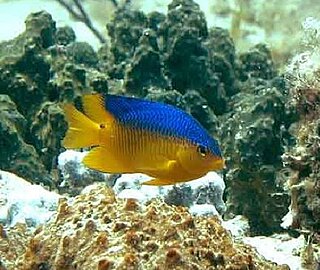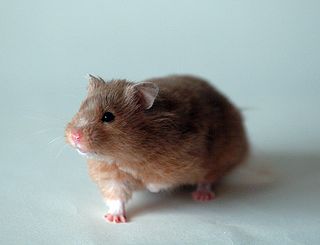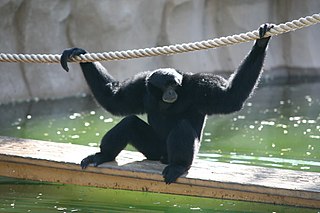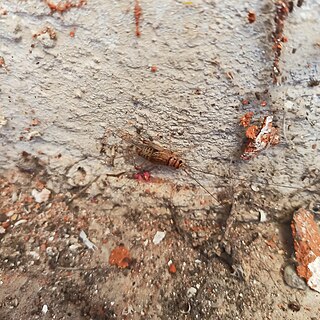
Hamsters are rodents belonging to the subfamily Cricetinae, which contains 19 species classified in seven genera. They have become established as popular small pets. The best-known species of hamster is the golden or Syrian hamster, which is the type most commonly kept as a pet. Other hamster species commonly kept as pets are the three species of dwarf hamster, Campbell's dwarf hamster, the winter white dwarf hamster and the Roborovski hamster.

The neon tetra is a Freshwater fish of the characin family of order Characiformes. The type species of its genus, it is native to blackwater and clearwater streams in the Amazon basin of South America. Its bright colouring makes the fish visible to conspecifics in the dark blackwater streams, and is also the main reason for its popularity among freshwater fish hobbyists, with neon tetras being one of the most widely kept tropical fish in the world.

The milk snake or milksnake, is a species of kingsnake; 24 subspecies are currently recognized. Lampropeltis elapsoides, the scarlet kingsnake, was formerly classified as a 25th subspecies, but is now recognized as a distinct species. The subspecies have strikingly different appearances, and many of them have their own common names. Some authorities suggest that this species could be split into several separate species. They are not venomous to humans.

The ball python, also called the royal python, is a python species native to West and Central Africa, where it lives in grasslands, shrublands and open forests. This nonvenomous constrictor is the smallest of the African pythons, growing to a maximum length of 182 cm (72 in). The name "ball python" refers to its tendency to curl into a ball when stressed or frightened.

Damselfish are those within the subfamilies Abudefdufinae, Chrominae, Lepidozyginae, Pomacentrinae, and Stegastinae within the family Pomacentridae. Most species within this group are relatively small, with the largest species being about 30cm in length. Most damselfish species exist only in marine environments, but a few inhabit brackish or fresh water. These fish are found globally in tropical, subtropical, and temperate waters.

The golden hamster or Syrian hamster is a rodent belonging to the hamster subfamily, Cricetinae. Their natural geographical range is in an arid region of northern Syria and southern Turkey. Their numbers have been declining in the wild due to a loss of habitat from agriculture and deliberate elimination by humans. Thus, wild golden hamsters are now considered endangered by the International Union for Conservation of Nature. However, captive breeding programs are well-established, and captive-bred golden hamsters are often kept as small house pets. They are also used as scientific research animals.

The siamang is an arboreal, black-furred gibbon native to the forests of Indonesia, Malaysia, and Thailand. The largest of the gibbons, the siamang can be twice the size of other gibbons, reaching 1 m (3.3 ft) in height, and weighing up to 14 kg (31 lb). It is the only species in the genus Symphalangus. Fossils of siamangs date back to the Middle Pleistocene.

The fire-bellied toads are a group of six species of small frogs belonging to the genus Bombina.

Pygmy marmosets are two species of small New World monkeys in the genus Cebuella. They are native to rainforests of the western Amazon Basin in South America. These primates are notable for being the smallest monkeys in the world, at just over 100 g (3.5 oz). They are generally found in evergreen and river-edge forests and are gum-feeding specialists, or gummivores.

A fancy mouse is a domesticated form of the house mouse, one of many species of mice, usually kept as a type of pocket pet. Fancy mice have also been specially bred for exhibiting, with shows being held internationally. A pet mouse is inexpensive compared to larger pets, and even many other pet rodents, but mice are comparatively short-lived: typically only 2 to 3 years.

The banded bullfrog is a species of frog in the narrow-mouthed frog family Microhylidae. Native to Southeast Asia, it is also known as the Asian painted frog, digging frog, Malaysian bullfrog, common Asian frog, and painted balloon frog. In the pet trade, it is sometimes called the chubby frog. Adults measure 5.4 to 7.5 cm and have a dark brown back with stripes that vary from copper-brown to salmon pink.

The queen butterfly is a North and South American butterfly in the family Nymphalidae with a wingspan of 80–85 mm. It is orange or brown with black wing borders and small white forewing spots on its dorsal wing surface, and reddish ventral wing surface fairly similar to the dorsal surface. The ventral hindwings have black veins and small white spots in a black border. The male has a black androconial scent patch on its dorsal hindwings. It can be found in meadows, fields, marshes, deserts, and at the edges of forests.

Live food is living animals used as food for other carnivorous or omnivorous animals kept in captivity; in other words, small preys fed alive to larger predators kept either in a zoo or as a pet.

Gryllus bimaculatus is a species of cricket in the subfamily Gryllinae. Most commonly known as the two-spotted cricket, it has also been called the "African" or "Mediterranean field cricket", although its recorded distribution also includes much of Asia, including China and Indochina through to Borneo. It can be discriminated from other Gryllus species by the two dot-like marks on the base of its wings.

The Cozumel raccoon is a critically endangered species of island raccoon endemic on Cozumel Island off the coast of the Yucatan Peninsula, Mexico. It is sometimes also called the pygmy raccoon, dwarf raccoon, Cozumel Island raccoon, and Cozumel raccoon bear.

Fathead minnow, also known as fathead or tuffy, is a species of temperate freshwater fish belonging to the genus Pimephales of the cyprinid family. The natural geographic range extends throughout much of North America, from central Canada south along the Rockies to Texas, and east to Virginia and the Northeastern United States. This minnow has also been introduced to many other areas via bait bucket releases. Its golden, or xanthic, strain, known as the rosy-red minnow, is a very common feeder fish sold in the United States and Canada. This fish is best known for producing Schreckstoff.

The East African armadillo lizard, dwarf sungazer, or tropical girdled lizard is a species of arboreal or rupicolous (rock-dwelling) lizard endemic to East Africa.

Crickets are orthopteran insects which are related to bush crickets, and, more distantly, to grasshoppers. In older literature, such as Imms, "crickets" were placed at the family level, but contemporary authorities including Otte now place them in the superfamily Grylloidea. The word has been used in combination to describe more distantly related taxa in the suborder Ensifera, such as king crickets and mole crickets.

Gryllodes is a genus of crickets in the family Gryllidae and tribe Gryllini. Species have been recorded in Australia, Asia, Africa (Ethiopia), central Europe, subtropical and tropical Americas.



















